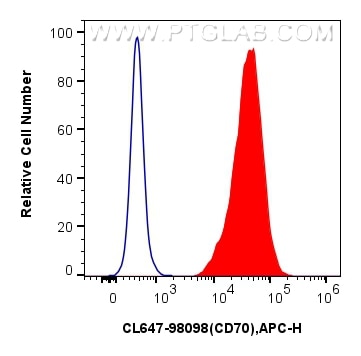Tested Applications
| Positive FC detected in | U266 cells |
Recommended dilution
| Application | Dilution |
|---|---|
| Flow Cytometry (FC) | FC : 5 ul per 10^6 cells in 100 μl suspension |
| This reagent has been pre-titrated and tested for flow cytometric analysis. The suggested use of this reagent is 5 ul per 10^6 cells in a 100 µl suspension or 5 ul per 100 µl of whole blood. | |
| Sample-dependent, Check data in validation data gallery. | |
Product Information
CL647-98098 targets CD70 in FC applications and shows reactivity with human samples.
| Tested Reactivity | human |
| Host / Isotype | Rabbit / IgG |
| Class | Recombinant |
| Type | Antibody |
| Immunogen |
Recombinant Protein Predict reactive species |
| Full Name | CD70 molecule |
| Calculated Molecular Weight | 21 kDa |
| GenBank Accession Number | BC000725 |
| Gene Symbol | CD70 |
| Gene ID (NCBI) | 970 |
| Conjugate | CoraLite® Plus 647 Fluorescent Dye |
| Excitation/Emission Maxima Wavelengths | 654 nm / 674 nm |
| Form | Liquid |
| Purification Method | Protein A purification |
| UNIPROT ID | P32970 |
| Storage Buffer | PBS with 0.09% sodium azide and 0.5% BSA, pH 7.3. |
| Storage Conditions | Store at 2-8°C. Avoid exposure to light. Stable for one year after shipment. |
Background Information
CD70, also known as tumor necrosis factor ligand superfamily member 7 (TNFSF7) or CD27 ligand (CD27L), is a transmembrane protein that plays a significant role in the immune system. It is the unique ligand for CD27, a member of the tumor necrosis factor receptor (TNFR) family, and is transiently upregulated upon stimulation of immune cells. CD70 is expressed on lymphocytes and dendritic cells, and its expression can be regulated by activation signals received via toll-like receptors (TLRs), CD40, and the antigen receptor MHC II. It provides complex and not completely understood signaling for B cell development. CD70 is also expressed on various solid tumors and hematolymphoid malignancies, where it may contribute to a poor prognosis.
Protocols
| Product Specific Protocols | |
|---|---|
| FC protocol for CL Plus 647 CD70 antibody CL647-98098 | Download protocol |
| Standard Protocols | |
|---|---|
| Click here to view our Standard Protocols |




